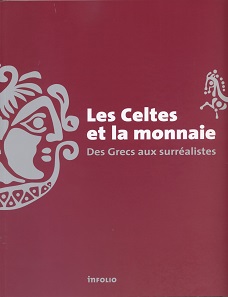by Ursula Kampmann
translated by Leonie Schulze
July 5, 2018 – For years I was looking for a book on Celtic coins that I would read from the first to its last page. Yes, there are countless catalogs out there, but I was still missing an actual summary. Now it is here. “Les Celtes et la monnaie” is a book you want to give to anyone who is interested in Celtic coins. So long as they know French, that is.
Julia Genechesi, Lionel Pernet (Ed.), Les Celtes et la monnaie. Des Grecs aux surréalistes. Infolio éditions, Gollion 2017. 167 pp., illustrated throughout. Paperback. 23 x 28 cm. ISBN: 978-2-88474-397-6. 32 Euro / 35 CHF.
Let’s begin with the obvious. This book is beautiful! Congratulations on the design and even more so on the intelligent outline! The history of Celtic coins is told in four chapters. The first one is concerned with the question of why and how the Celts began minting coins in the first place. The second chapter looks at the spread of coins as a form of payment in the Celtic regions. In the third chapter we witness the heyday of Celtic numismatics in a free Gaul, while the fourth chapter describes the final phase up until the absorption into the Roman Empire.
This catalog was originally published in the context of an exhibition that was organized by the Musée cantonal d’archéologie et d’histoire in Lausanne in 2017. But the catalog was designed to be more than an exhibition catalog from the very beginning. And they managed to do just that.
33 authors have contributed to this book and we have to compliment the editors Julia Genechesi and Lionel Pernet for successfully combining all of these different voices in one coherent work. Numerous shorter subchapters complement the four main chapters in dealing with certain technical questions or explaining special find complexes. Every single writer certainly has their own style and their own focus, but the dominant chronological outline holds the entire book together and provides the right spot for every single contribution.
The last chapter is the only one that appears short-changed. This is where the fact that Celtic numismatics is largely dominated by archaeologists takes its toll. Chapter 5 is dedicated to images that are depicted on Celtic coins. As a reader, I would have hoped for some more detailed explanations here. Instead of asking why women are not depicted on Celtic coins, I would have been more interested in learning what we can actually see on Celtic coins – except for fantastic animals, who got their own chapter. The current state of research regarding the evaluation of these depictions is also missing.
However, this minor criticism is not supposed to take away from my enthusiasm for this book. Its clear-cut outline puts in order all of the little bits of knowledge that we have collected on Celtic numismatics over time. It truly is an amazing book for all those who are looking to get an overview of the history of Celtic coins. And that is even worth digging out whatever is left of the French we learned at school.
You can buy your copy directly from the infolio website.





